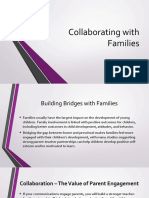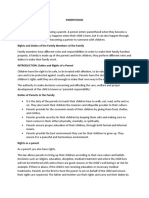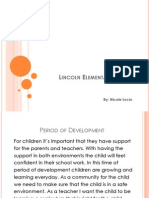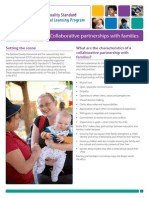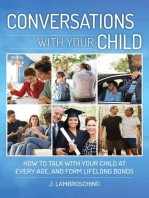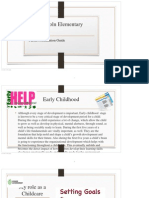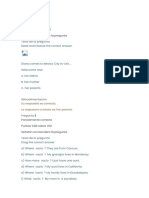0 ratings0% found this document useful (0 votes)
167 viewsWeek 3 - Assignment For Ece 497
Week 3 - Assignment For Ece 497
Uploaded by
api-266952418The document discusses how family and community involvement affects children. It covers different developmental stages in early and middle childhood and the role of teachers. It also outlines Epstein's six types of parental involvement, including parenting, communicating, volunteering, learning at home, decision making, and collaborating with the community.
Copyright:
© All Rights Reserved
Available Formats
Download as PPTX, PDF, TXT or read online from Scribd
Week 3 - Assignment For Ece 497
Week 3 - Assignment For Ece 497
Uploaded by
api-2669524180 ratings0% found this document useful (0 votes)
167 views13 pagesThe document discusses how family and community involvement affects children. It covers different developmental stages in early and middle childhood and the role of teachers. It also outlines Epstein's six types of parental involvement, including parenting, communicating, volunteering, learning at home, decision making, and collaborating with the community.
Original Title
week 3- assignment for ece 497
Copyright
© © All Rights Reserved
Available Formats
PPTX, PDF, TXT or read online from Scribd
Share this document
Did you find this document useful?
Is this content inappropriate?
The document discusses how family and community involvement affects children. It covers different developmental stages in early and middle childhood and the role of teachers. It also outlines Epstein's six types of parental involvement, including parenting, communicating, volunteering, learning at home, decision making, and collaborating with the community.
Copyright:
© All Rights Reserved
Available Formats
Download as PPTX, PDF, TXT or read online from Scribd
Download as pptx, pdf, or txt
0 ratings0% found this document useful (0 votes)
167 views13 pagesWeek 3 - Assignment For Ece 497
Week 3 - Assignment For Ece 497
Uploaded by
api-266952418The document discusses how family and community involvement affects children. It covers different developmental stages in early and middle childhood and the role of teachers. It also outlines Epstein's six types of parental involvement, including parenting, communicating, volunteering, learning at home, decision making, and collaborating with the community.
Copyright:
© All Rights Reserved
Available Formats
Download as PPTX, PDF, TXT or read online from Scribd
Download as pptx, pdf, or txt
You are on page 1of 13
FAMILY AND COMMUNITY
INVOLVEMENT AND HOW IT
AFFECTS CHILDREN
Jessica Ohl
ECE 497
Pilar Carroll
September 28, 2014
EARLY CHILDHOOD AND MIDDLE
CHILDHOOD
With different ages, come different developmental standards. Early
childhood children are at the age where they look up to their parents,
grandparents, and other adults in their lives. From Pre-K to 6
th
Grade, children
are beginning to learn many new things that are preparing them for their
adolescent years. During this age there will be many changes occurring in
their lives and in their bodies and as those who they look up to we must be
prepared to help them through it all.
TEACHERS PART IN CHILDRENS
LIVES
As a Child Development professional, it is my job to ensure that each child I
come in to contact with receives the best education and care that they
deserve. If they have problems going on at home then I will make sure that
they know they can talk to me about it and I will do everything in my power
to make sure that they get the help they need.
RATIONALE FOR THE
PRESENTATION
Children are our future and finding the right ways in which to encourage and
support them is something that all parents, teachers, grandparents, and
community leaders should strive for. This presentation will highlight ways in
which to do this.
MESOSYSTEM
Microsystem
Childs self
Mesosystem
Family, School, Peers, and
Neighborhood
Exosystem
A childs interaction with all of
the above can change their
Exosystem.
Macrosystem
Doctors, School Officials,
Health Services, Extended
Family, Media.
Chronosystem
Government, Belief Systems,
and Material Resources.
EPSTEINS TYPES OF INVOLVEMENT
Epstein has Six types of Involvement that he feels should be taken into
consideration. They are:
Parenting
Communicating
Volunteering
Learning at Home
Decision Making
Collaborating with Community
PARENTING
Parenting makes a big impact on how a child behaves and who they
become. If the parent is not around that often the child is not getting all the
necessary involvement that they should be getting. Parenting consist of taking
care of all their childs needs, helping them with school work, making sure they
are fed and clothed, and making sure that they are not harmed in any way.
COMMUNICATION
Communication can mean having a face to face meeting with the teacher
when a problem arises with their child, or the teacher sending a letter home to
keep the parent on track with what their child is learning and how they are
doing in the class.
Ways to get parents and the community involved is to invite them into the
classroom to share what jobs they do, what their culture is about, and/or
taking a field trip with the children to visit places so that they can learn from
them.
VOLUNTEERING
Going out in to the community and volunteering will help children to learn that
by helping others we are making sure that they have all they need even when
they are struggling to get it on their own.
Ways in which to volunteer in the classroom would be to talk to the teacher
and see if there is anything that they need you to help with and also letting
them know when you can work. Coming in to help read to the children, grade
papers, or just being a listening ear when the child may need it.
LEARNING AT HOME
Learning begins at home and at an early age. When teachers send home
work, then it is the responsibility for the parents to make sure that the child
completes it.
Getting the parents and child care providers into helping children learn and
ways in which to do it as a child development professional is send home
projects that can be done as a family and also finding ways in which to get
the parents into the classroom.
DECISION MAKING
Working together; parents, teachers, and child, can make the decision
process much easier on children.
Way in which parents and children can make positive decisions is too:
Talk it over with their spouse and for children talking to their parents
Talk to the teacher and find out what they feel is the right way to help them
Parents should talk to the child and ask them their ides on the problem and then
let them decide. If the decision is going to harm them than the parent must step
in, but allowing them to make their own decision and learn from them will help
them to become stronger.
COLLABORATING WITH THE
COMMUNITY
The community around a child can make a big impact on that child.
Involving the community in school activities and allowing them to teach
what they know to the children can make the children feel that they are
learning more about where they come from.
Setting up a fair and bringing in different businesses to share what they do
and how they help the community can make children want to work at one
of those places when they are older. It takes more than the parents to raise
a child and everyone should remember this.
REFERENCES
Berk, L. E. (2013).Child Development. (9th ed.). Upper Saddle River, NJ: Pearson.
Bradley, R. H. (2010). From home to day care: Chaos in the family/child-care
mesosystem. In G. W. Evans, T. D. Wachs (Eds.) , Chaos and its influence on children's
development: An ecological perspective (pp. 135-153). American Psychological
Association. doi:10.1037/12057-009
Griffin, D., & Steen, S. (2010). School-Family-Community Partnerships: Applying
Epstein's Theory of the Six Types of Involvement to School Counselor Practice.
Professional School Counseling, 13(4), 218-226.
Jang, J., & Kim, Y. (2012). The effects of parentchild communication patterns on
children's interactive communication in online communities: focusing on social self-
efficacy and unwillingness to communicate as mediating factors. Asian Journal Of
Communication, 22(5), 493-505. doi:10.1080/01292986.2012.701314
You might also like
- Families and Educators Together: Building Great Relationships that Support Young ChildrenFrom EverandFamilies and Educators Together: Building Great Relationships that Support Young ChildrenNo ratings yet
- 11 Plus Schools & Exam Information Parent's Guide - HUNARlyDocument1 page11 Plus Schools & Exam Information Parent's Guide - HUNARlyssdipaNo ratings yet
- Roles and Responsibilities of Family and MembersDocument2 pagesRoles and Responsibilities of Family and MembersMillie Lagonilla100% (9)
- Yoshino - The Epistemic Contract of Bisexual ErasureDocument110 pagesYoshino - The Epistemic Contract of Bisexual ErasureMathieu TrachmanNo ratings yet
- Kids Brazilian Jiu-JitsuDocument2 pagesKids Brazilian Jiu-JitsuRenzo Gracie Garwood100% (1)
- Helping Your Child Get Ready For SchoolDocument50 pagesHelping Your Child Get Ready For SchoolCarlaNo ratings yet
- It Takes A VillageDocument13 pagesIt Takes A Villageapi-281021657No ratings yet
- Parent Presenation - Ece 497Document14 pagesParent Presenation - Ece 497api-263079141No ratings yet
- Parent PresentationDocument16 pagesParent Presentationapi-268213710No ratings yet
- Parent Presentation FinalDocument20 pagesParent Presentation Finalapi-246379610100% (1)
- Adair Formalpaper1Document7 pagesAdair Formalpaper1api-307374574No ratings yet
- How To Really Listen To ParentsDocument6 pagesHow To Really Listen To ParentsjandersoneceNo ratings yet
- Presentation 1Document12 pagesPresentation 1api-351330683No ratings yet
- Collaborating With FamiliesDocument14 pagesCollaborating With Familiesjoreina ramosNo ratings yet
- Partnering For Our Kids FinalDocument12 pagesPartnering For Our Kids Finalapi-256424585No ratings yet
- Parents Rearing A ChildDocument30 pagesParents Rearing A ChildIsabel BantayanNo ratings yet
- Ve-11 Report Parenthoodgroup-4Document5 pagesVe-11 Report Parenthoodgroup-4Christian Dave TitularNo ratings yet
- Argumentative EssayDocument7 pagesArgumentative EssaycwcolleenNo ratings yet
- Parent Presentation Patricia Boone ECE497: Child Development Katherine Palichuk June 22, 2015Document13 pagesParent Presentation Patricia Boone ECE497: Child Development Katherine Palichuk June 22, 2015api-290034087No ratings yet
- Week 3 As 1Document12 pagesWeek 3 As 1api-367632595No ratings yet
- Final Ece497Document10 pagesFinal Ece497api-250424722No ratings yet
- Communicating With Children Improves Parent Child RelationshipsDocument8 pagesCommunicating With Children Improves Parent Child Relationshipsapi-252618091No ratings yet
- Running Head: Statement of Informed Beliefs 1Document8 pagesRunning Head: Statement of Informed Beliefs 1api-302824987No ratings yet
- Topic 9: Family and CommunityDocument23 pagesTopic 9: Family and CommunityNorina Mohamad NajibNo ratings yet
- Finaldraft2 1Document7 pagesFinaldraft2 1api-354956404No ratings yet
- Parents First: Parents and Children Learning TogetherFrom EverandParents First: Parents and Children Learning TogetherRating: 2 out of 5 stars2/5 (1)
- Teenagers Wellbeing d3Document36 pagesTeenagers Wellbeing d3imadudin20076707100% (1)
- Research PaperDocument8 pagesResearch Paperapi-2520240860% (1)
- FS1 Episode 4Document4 pagesFS1 Episode 4Blessy QuimnoNo ratings yet
- Presentation1 ParentDocument13 pagesPresentation1 Parentapi-289748229No ratings yet
- Field Study 1 (Episode4)Document4 pagesField Study 1 (Episode4)Ms.BaeNo ratings yet
- GH 6611Document6 pagesGH 6611api-245731944No ratings yet
- Nqs PLP E-Newsletter No35 Collaborative Partnerships With FamiliesDocument5 pagesNqs PLP E-Newsletter No35 Collaborative Partnerships With Familiesapi-267341620No ratings yet
- Conversations with Your Child: How to Talk with Your Child at Every Age and Form Lifelong BondsFrom EverandConversations with Your Child: How to Talk with Your Child at Every Age and Form Lifelong BondsNo ratings yet
- Greetings From The Superintendent: Parent PowerDocument5 pagesGreetings From The Superintendent: Parent PowerAnonymous IF7SCdlb53No ratings yet
- Ece 497 Week 3 Assignmt Parent PresentationDocument19 pagesEce 497 Week 3 Assignmt Parent Presentationapi-281034615No ratings yet
- Childcare Power PointDocument12 pagesChildcare Power Pointdwhitney100100% (1)
- FS 1 - Episode 4Document2 pagesFS 1 - Episode 4Zaide MangondatoNo ratings yet
- CommentaryDocument4 pagesCommentaryapi-315550012No ratings yet
- wk8 Health Nutrition and SafetyDocument14 pageswk8 Health Nutrition and SafetyRci-Ched Mira CaparasNo ratings yet
- Ece 497 Parent PresentationDocument18 pagesEce 497 Parent Presentationapi-385808782No ratings yet
- Parent PresentationDocument16 pagesParent Presentationapi-258174505No ratings yet
- Lincoln Elementary 8363165-Notes-ExportDocument12 pagesLincoln Elementary 8363165-Notes-Exportapi-296983133No ratings yet
- The Role of Parents in EducationDocument6 pagesThe Role of Parents in EducationJennifer Munoz HernandezNo ratings yet
- Reece Final Case StudyDocument15 pagesReece Final Case Studyapi-501003650No ratings yet
- Government Collegesof Nursing: C.R.P Line Indore Subject - Practice Teaching Class OnDocument21 pagesGovernment Collegesof Nursing: C.R.P Line Indore Subject - Practice Teaching Class OnPragati BholeNo ratings yet
- Parenthood and ParentingDocument12 pagesParenthood and ParentingKoushik ChakrabortyNo ratings yet
- FS Learning Episode 4 1Document10 pagesFS Learning Episode 4 1RACHEL MAI GARCIANo ratings yet
- Working With Parents - Building Relationships For StudentDocument68 pagesWorking With Parents - Building Relationships For StudentfilmwithvaiNo ratings yet
- By Pastor AngelDocument5 pagesBy Pastor Angelangel riyandaneNo ratings yet
- Formal 1Document7 pagesFormal 1api-295612298No ratings yet
- External Factors ValuesDocument51 pagesExternal Factors Valuesdavid juddNo ratings yet
- Nqs PLP E-Newsletter No68Document5 pagesNqs PLP E-Newsletter No68api-243291083No ratings yet
- The Art of Parenting Together: How to Be Good Parents Together by Using Dynamic Parenting to Improve Your Kid's Childhood: The Master Parenting Series, #16From EverandThe Art of Parenting Together: How to Be Good Parents Together by Using Dynamic Parenting to Improve Your Kid's Childhood: The Master Parenting Series, #16No ratings yet
- Week3 AssignmentDocument13 pagesWeek3 Assignmentapi-268830339No ratings yet
- Parenting Styles Essay ThesisDocument7 pagesParenting Styles Essay Thesissarahturnerdesmoines100% (1)
- Tgildea ParentinvolvementactionresearchpaperDocument15 pagesTgildea Parentinvolvementactionresearchpaperapi-221924643No ratings yet
- Lesson 5 Supporting Families of Children With Special NeedsDocument27 pagesLesson 5 Supporting Families of Children With Special NeedsVillaflor, Kyle L.No ratings yet
- Making Most of ChildhoodDocument4 pagesMaking Most of ChildhoodNguyễn DungNo ratings yet
- The Parenting Bible: The parenting toolbox essentials & guide to using the best parenting styles for toddlers to teens, boys & girls, kind kids to strong willed explosive child, & difficult childrenFrom EverandThe Parenting Bible: The parenting toolbox essentials & guide to using the best parenting styles for toddlers to teens, boys & girls, kind kids to strong willed explosive child, & difficult childrenNo ratings yet
- Positive Parenting 1Document20 pagesPositive Parenting 1Vinod K Pillai100% (1)
- Examen D'anglèsDocument8 pagesExamen D'anglèsRAC1No ratings yet
- MayeDocument15 pagesMayeJeremias De la Cruz100% (2)
- March 2011 NewsletterDocument9 pagesMarch 2011 NewsletterlikelikeschoolNo ratings yet
- Eapp-Position PaperDocument4 pagesEapp-Position Paperangeligaleno50% (2)
- Culture and Ethnic Groups in East AfricaDocument3 pagesCulture and Ethnic Groups in East Africamc killoNo ratings yet
- (Tailieupro.com) Sách Bài tập tiếng Anh 12 Mai Lan Hương có đáp án PDFDocument307 pages(Tailieupro.com) Sách Bài tập tiếng Anh 12 Mai Lan Hương có đáp án PDFSUENo ratings yet
- Child Care Facilities List March 23Document20 pagesChild Care Facilities List March 23Jennifer MontielNo ratings yet
- Career CounsellingDocument10 pagesCareer CounsellingjithabhasuNo ratings yet
- SURVEYDocument1 pageSURVEYMiracle WhitesNo ratings yet
- 2006, Globalizing Intimacy-The Role of Information and Communication Technologies in Maintaining and Creating RelationshipsDocument30 pages2006, Globalizing Intimacy-The Role of Information and Communication Technologies in Maintaining and Creating RelationshipsMissbee13No ratings yet
- Personal RelationshipDocument34 pagesPersonal RelationshipHexél AmityNo ratings yet
- Why Is Sex FunDocument2 pagesWhy Is Sex FunkarinadegomaNo ratings yet
- Trauma History Questionnaire: Crime-Related EventsDocument3 pagesTrauma History Questionnaire: Crime-Related EventsHimanshi Manish WaliaNo ratings yet
- Speech Luisa EsplanadaDocument3 pagesSpeech Luisa EsplanadaLuisa EsplanadaNo ratings yet
- Lesson 16: Gender-Based Violence: Power, Use of Force and ConsentDocument14 pagesLesson 16: Gender-Based Violence: Power, Use of Force and ConsentCyra Mandigma100% (2)
- Antibully WordsearchDocument2 pagesAntibully WordsearchliehokgieNo ratings yet
- Documento 7Document13 pagesDocumento 7Coca VerduzcoNo ratings yet
- Early Adulthood Socio-EmotionalDocument23 pagesEarly Adulthood Socio-EmotionalsohaNo ratings yet
- Family Report 2018 BDocument9 pagesFamily Report 2018 BalannainsanityNo ratings yet
- Tnkey Im v20Document31 pagesTnkey Im v20api-513413901No ratings yet
- SSPC Overview of Singapore Families 020615Document37 pagesSSPC Overview of Singapore Families 020615DamaNo ratings yet
- The Causes of Baby DumpingDocument2 pagesThe Causes of Baby Dumpingsirthana697547No ratings yet
- Sissy 1Document3 pagesSissy 1Trixy tangNo ratings yet
- CH 14 Emotional Development in Early AdulthoodDocument14 pagesCH 14 Emotional Development in Early AdulthoodMark Charle ManaNo ratings yet
- Analyzing Trust Issue Due To Infidelity: Lack of Commitment in The Dating RelationshipDocument6 pagesAnalyzing Trust Issue Due To Infidelity: Lack of Commitment in The Dating RelationshipghaisaniNo ratings yet
- A Study On The Effects of Broken Home Towards The Learners' Behavior and Academic PerformanceDocument39 pagesA Study On The Effects of Broken Home Towards The Learners' Behavior and Academic PerformanceAesir ArchitectNo ratings yet
- Alfred Adler in The LGBT Community-3Document12 pagesAlfred Adler in The LGBT Community-3Michael A TaylorNo ratings yet













